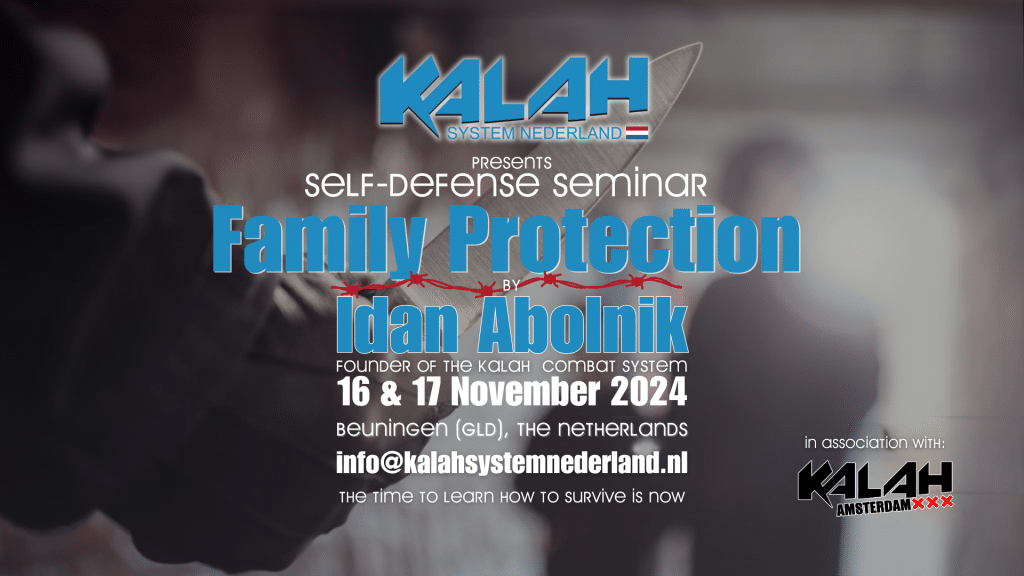As Violence Surges, Families Seek New Ways to Protect Themselves
In a world where urban streets are becoming unpredictable, the safety of one’s home and family can no longer be taken for granted. While overall crime rates in the Netherlands have been in decline for years, a recent uptick in violent incidents, particularly in cities like Amsterdam and Rotterdam, has families asking: What can we do to protect ourselves when crime comes knocking at our door?
With organized crime on the rise and urban life more fraught than ever, many are turning to last-resort solutions like the Kalah Combat System—a practical and highly effective self-defense method designed for life-threatening, “fight or die” scenarios. But is self-defense the whole answer, or just a piece of a much bigger puzzle? And what role does mental resilience play in facing these new dangers?
Let’s explore how crime trends are evolving, the psychological impact on families, and why the ability to protect ourselves is more critical than ever.
The Rising Threat of Urban Crime
In recent years, violent crime has been on the rise in urban centers across Europe. According to the Veiligheidsmonitor 2023 from the Centraal Bureau voor de Statistiek (CBS), traditional crimes like home invasions and assaults have seen an increase, with 20% of the Dutch population affected by crime in 2023, up from 17% in 2021 (CBS, 2023). In cities like Amsterdam, the numbers are particularly troubling.
So what’s driving this surge in violent crime?
Socio-economic factors, including income inequality and social disorganization, play a major role. Densely populated urban areas often provide the perfect conditions for criminal activity. According to routine activity theory, which suggests that crime occurs when motivated offenders encounter suitable targets without capable guardians, cities present more opportunities for crime (Cohen & Felson, 1979). Moreover, reports from Europol indicate that organized crime groups are increasingly resorting to violence to achieve their aims, contributing to the rise in violent incidents across Europe (Europol, 2021).
As urban centers become hotspots for violent crime, families must face the uncomfortable reality that, despite best efforts to avoid dangerous situations, they may still encounter violence.
How Families are Responding: Seeking Safety in Unpredictable Times
The Psychological Toll of Crime on Families
Exposure to violent crime affects not only the victims but also the families and communities around them. Studies have shown that violent incidents, or even the perception of danger, can lead to anxiety, PTSD, and chronic fear (American Psychological Association [APA], 2013). Children and elderly individuals are particularly vulnerable to the long-term effects of trauma, with children often exhibiting behavioral changes such as aggression or withdrawal (Bonanno, 2004).
Even the fear of crime—without direct victimization—has a profound impact. Brunton-Smith et. al. (2011) highlight how fear weakens community cohesion, leading to reduced social interaction and eroding the trust necessary for strong neighborhoods. When people feel unsafe in their own homes and communities, the psychological toll can be devastating.
Why Self-Defense is Not Just About Physical Safety
Amid these rising concerns, families are increasingly turning to self-defense systems to regain control. Programs like the Kalah Combat System, specifically designed for real-world violence, offer more than just physical techniques—they build mental resilience. Research on self-defense programs shows that training significantly improves situational awareness and the ability to make rapid decisions under pressure, empowering individuals to handle extreme stress (Hollander, 2018).
The Kalah Combat System goes beyond traditional martial arts, focusing on practical solutions to violent situations that leave no room for escape. But self-defense is not just about learning how to fight—it’s about fostering a mindset that can handle violence in those critical moments when there are no other options left.
Why the Kalah Combat System is a Game-Changer
The “Fight or Die” Approach
Unlike many traditional self-defense methods, the Kalah Combat System teaches participants to respond decisively in situations where violence is inevitable. The system’s techniques are designed for high-stress, life-threatening scenarios—home invasions, armed assaults, and street attacks. In these moments, Kalah offers simple, effective solutions aimed at neutralizing the threat as quickly as possible.
Studies on similar systems, such as Krav Maga, have shown that these methods are highly effective in real-world scenarios. Participants report improved self-confidence and an enhanced ability to manage violent encounters (Ozer et al., 1999). Hollander (2018) notes that programs like Kalah not only equip individuals with the tools for physical defense but also reduce the psychological impact of violent encounters by building mental resilience.
Why Mental Resilience is Key in Family Protection and Self-Defense
One of the most powerful aspects of Kalah is its emphasis on mental conditioning. In violent situations, it’s not enough to know how to throw a punch—mental resilience, the ability to stay calm under pressure, can be the difference between life and death. Boxer & Sloan-Power (2013) found that mental resilience training helps individuals recover from trauma and reduces the likelihood of long-term psychological damage after violent incidents.
Kalah, therefore, does more than teach participants how to defend themselves physically—it equips them with the mental tools to withstand and recover from the psychological toll of violence.
Integrating Self-Defense into a Comprehensive Protection Plan
Family Protection is a Multi-Layered Approach
While self-defense is critical, it works best as part of a broader strategy. Families should combine physical training with other layers of protection, such as community policing and situational awareness. Studies have shown that community policing efforts reduce violent crimes by fostering relationships between law enforcement and residents, increasing trust, and encouraging more proactive reporting of suspicious activities (Ekici et al., 2022).
Urban planning also plays a role in crime prevention. Crime Prevention Through Environmental Design (CPTED), which advocates for the strategic placement of lighting, surveillance, and open spaces, has been proven to reduce crime by making it harder for offenders to act unnoticed (Newman, 1972). Together, these strategies form a comprehensive protection plan.
The Power of Proactivity
Taking a proactive approach to family protection can significantly reduce the fear and anxiety associated with violent crime. Self-defense training like Kalah not only prepares individuals for worst-case scenarios but also gives them the confidence that comes from knowing they are capable of protecting themselves and their loved ones.
The Family Protection Seminar: Prepare for the Worst
If you want to be prepared for the unthinkable, the Family Protection Seminar on November 16 & 17, 2024, at the House of Boxing in Beuningen is the perfect opportunity to learn life-saving techniques from the Kalah Combat System. This seminar offers hands-on training in both mental and physical defense, ensuring you and your family are ready to handle even the most dangerous situations.
- Event Details:
At the seminar, you’ll learn how to defend against several worst-case scenarios. You’ll also gain critical mental resilience techniques that prepare you to remain calm and make life-saving decisions under pressure.
Don’t wait for bad luck to strike—prepare your family now by registering for this crucial seminar.
Taking Control of Family Safety
While violent crime may be on the rise, families are not powerless. Through self-defense systems like Kalah, combined with broader community protection strategies, families can regain control over their safety. The key is not only in the ability to fight but in building mental resilience and preparing for the unexpected.
By taking proactive steps—whether through training, neighborhood involvement, or awareness programs—families can transform fear into empowerment and stand ready to face whatever challenges come their way.
The Family Protection Seminar is your next step in securing peace of mind. Join us and ensure you have the skills and mindset needed when safety is no longer a given.

References
Agnew, R. (2006). Pressured into crime: An overview of general strain theory. Oxford University Press.
American Psychological Association. (2013). Trauma and post-traumatic stress disorder (PTSD). Retrieved from https://www.apa.org/topics/ptsd
Arfsten, Kerrin-Sina. (2020). Before, Now, and After the Event of Terror: Situational Terror Awareness for Civilians in US Homeland Security. European Journal for Security Research. https://link.springer.com/article/10.1007/s41125-019-00054-9
Bonanno, G. A. (2004). Loss, trauma, and human resilience: Have we underestimated the human capacity to thrive after extremely aversive events? American Psychologist, 59(1), 20-28. https://doi.org/10.1037/0003-066X.59.1.20
Boxer, P., & Sloan-Power, E. (2013). Effects of community violence on children’s development: Emotional, behavioral, and regulatory influences. Clinical Child and Family Psychology Review, 16(3), 289-298. https://doi.org/10.1146/annurev.psych.51.1.445
Brunton-Smith, I., & Sturgis, P. (2011). Do neighborhoods generate fear of crime? An empirical test using the British Crime Survey. Criminology, 49(2), 331-369. https://doi.org/10.1111/j.1745-9125.2011.00228.x
Centraal Bureau voor de Statistiek. (2023). Veiligheidsmonitor 2023. Retrieved from https://open.overheid.nl/documenten/dpc-9a9f6b051ff743f1b469040b00d8946351c6f009/pdf
Cohen, L. E., & Felson, M. (1979). Social change and crime rate trends: A routine activity approach. American Sociological Review, 44(4), 588–608. https://doi.org/10.2307/2094589
Ekici, N., Akdogan, H., Kelly, R., & Gultekin, S. (2022). A meta-analysis of the impact of community policing on crime reduction. Journal of Community Safety and Well-Being, 7(3), 111–121. https://doi.org/10.35502/jcswb.244
Europol. (2021). Serious and organized crime threat assessment (SOCTA) 2021. Retrieved from https://www.europol.europa.eu/publications-events/main-reports/socta-report
Hollander, J. A. (2018). “I can take care of myself”: The impact of self-defense training on women’s lives. Violence Against Women, 24(10), 205-235. http://dx.doi.org/10.1177/1077801203256202
Newman, O. (1972). Defensible space: Crime prevention through urban design. Macmillan.
Ozer, E. J., & Bandura, A. (1990). Mechanisms governing empowerment effects: A self-efficacy analysis. Journal of Personality and Social Psychology, 58(3), 472-486. https://doi.org/10.1037/0022-3514.58.3.472
Welsh, B. C., & Farrington, D. P. (2009). Public area CCTV and crime prevention: An updated systematic review and meta-analysis. Justice Quarterly, 26(4), 716-745. http://dx.doi.org/10.1080/07418820802506206

